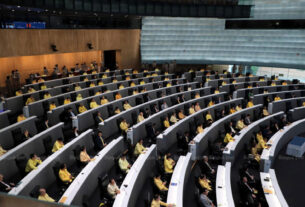The by-election in Nakhon Si Thammarat’s Constituency 8 concluded with a clear victory for Kongkiat Ketsobat of the Klatham Party, signaling a notable shift in southern Thai politics. With unofficial tallies placing Kongkiat well ahead of his rivals, the result underscored the Klatham Party’s rapid ascent in a province long influenced by established regional players. The polling day turnout reached around seventy percent, reflecting strong voter engagement in a contest triggered by a corruption scandal that toppled the sitting Bhumjaithai MP. As the Election Commission prepares to certify the outcome, party leaders in Nakhon Si Thammarat framed the victory as both a mandate and a foundation for future political expansion in the region. The Klatham Party emphasized that this win is more than a singular triumph; it marks the opening of a new chapter in southern politics, with implications that could reverberate through subsequent by-elections and potentially influence the balance among major national parties in the south.
Constituency 8 By-Election: Results, Turnout, and Immediate Aftermath
Kongkiat Ketsobat secured an unofficial victory in the by-election for Constituency 8, garnering 38,680 votes, according to the Election Commission’s initial tally released on Sunday. His nearest challenger, Sawai Lueangsinil of the Bhumjaithai Party, trailed with 28,417 votes. Other candidates included Nattakit Yuduang representing the People’s Party, who finished third with 6,811 votes, and veteran politician Chinnaworn Booyakiat of the Democrat Party, who received 4,190 votes. The EC noted that the official result would be formalized after administrative procedures and verification, but the margin and distribution of votes pointed to a decisive victory for Kongkiat and the Klatham Party. The constituency tally confirms a clear preference among voters in this district for the Klatham platform, aligning with broader signals about political realignment in the southern belt.
Constituency 8 encompasses the districts of Chawang, Phipun, Na Bon, and Chang Klang. Turnout was robust, with about seven in every ten eligible voters casting ballots on Sunday. This level of participation reinforces the legitimacy of the by-election result and indicates strong civic engagement, particularly in rural and semi-urban areas where political loyalties may be more fluid and highly responsive to local issues and candidate profiles. The by-election was necessitated after the Criminal Court removed Bhumjaithai MP Mukdawan Luengsinil from office for vote buying, a ruling that also imposed a ten-year political ban. The vacancy prompted Bhumjaithai to field a candidate to retain the seat, a move that ultimately did not translate into victory, highlighting a meaningful shift in voter sentiment. The election’s outcome thus serves as a barometer for how voters in this southern constituency respond to perceptions of corruption and the credibility of party candidates.
In the lead-up to polling day, Kongkiat Ketsobat’s campaign became emblematic of Klatham’s broader strategy: present a stable, pro-development image while appealing to local concerns. The election’s context also raised questions about party dynamics within the region, particularly given the recent history of the seat and the fact that Kongkiat is the son-in-law of Chinnaworn Booyakiat—a detail that underscores the tangled networks of local political families and alliances. The result, while a by-election, has been described by Klatham’s insiders as a turning point that could reshape the province’s political landscape in the years ahead.
The party’s victory added to the narrative that the Klatham Party can attract voters who may have once leaned toward traditional power brokers in NST. Analysts noted that the margin over Bhumjaithai signaled not merely a local triumph but a potential reorientation of support around issues like governance, development, and anti-corruption—issues that resonated with voters facing the consequences of recent political scandals. For the Klatham Party, this result validates their presence in NST and provides a tangible platform to expand their reach into neighboring districts and constituencies. The official certification by the EC, while pending, is anticipated to affirm the unofficial results and set the stage for the party to begin formalizing its regional operations, fundraising, and candidate pipelines for future electoral cycles.
In summary, Constituency 8’s by-election outcome demonstrates a moment of political renewal in Nakhon Si Thammarat, one that elevates Klatham’s profile and invites deeper examination of how new political entrants can challenge established parties within a historically complex southern political environment. The vote tallies reflect a clear preference among a broad cross-section of voters in Chawang, Phipun, Na Bon, and Chang Klang, signaling a potential realignment of local alliances and priorities that could influence both local governance and provincial policy directions in the months and years ahead.
Strategic Implications for the Klatham Party: Building a Regional Base in the South
The landslide-like victory achieved by Kongkiat Ketsobat in Constituency 8 is being interpreted by party strategists as not just a win in a single district but a strategic foothold for the Klatham Party in one of Thailand’s most politically intricate and competitive regions—the southern provinces. Thamanat Prompow, the Klatham Party’s de facto leader, highlighted the win as a reflection of broad voter confidence in the party’s vision and proposed policies. He asserted that the result demonstrates the electorate’s trust in Klatham to deliver tangible benefits and to foster a pathway for the party to consolidate its base in Nakhon Si Thammarat. In his assessment, the victory is not merely symbolic; it is a practical indication that Klatham can mobilize local networks, sustain campaign momentum, and convert a by-election success into durable, repeatable electoral gains in subsequent polls. The leadership was quick to frame the outcome as a foundation upon which to build long-term political infrastructure in the province, including the recruitment of capable local candidates, the establishment of constituency committees, and the development of issue-focused platforms tailored to NST’s unique needs.
The Klatham Party’s narrative around the election emphasizes the message of trust and continuity in a region that has historically seen significant influence from established national and regional players. The party’s chief adviser stated that “the foot of Klatham is set here,” signaling a deliberate strategy to embed the party’s presence in NST at the ground level. This language reflects a broader plan to convert a strong showing into a sustained political project characterized by local engagement, governance-centered discourse, and incremental seat gains across the province’s constituencies. The victory is being framed as validation of the party’s governance theme—an emphasis on accountability, public service delivery, and anti-corruption credentials—so as to appeal to voters who are seeking stability amid a shifting national political landscape.
Klatham’s leadership also suggested that the victory in NST could serve as a catalyst for expanding the party’s footprint beyond the province’s borders. Analysts note that Nakhon Si Thammarat has historically presented delicate electoral dynamics, where regional loyalties, family connections, and long-standing party presence interplay with candidate profiles and national party strategies. The party’s ability to mobilize a diverse coalition of voters—ranging from traditional Democrat-leaning segments to new supporters attracted by Klatham’s reform-oriented platform—will be critical to translating this win into a broader southern corridor strategy. The party’s organizers are reportedly mapping out a phased approach that prioritizes capacity-building in Constituency 8 and adjacent districts, followed by targeted outreach in neighboring constituencies where demographics and electoral history suggest potential for Klatham’s growth.
Narumon Pinyosinwat, the Klatham Party’s leader, publicly thanked voters for casting ballots and lending their support. Her remarks, like those of other senior party figures, framed the NST result as a collective achievement that would empower Klatham to pursue a more ambitious southern strategy. The party’s communications team has stressed a policy-oriented approach, promising concrete projects and regional development plans designed to address the economic and social priorities of NST residents. By foregrounding development, job creation, and improved public services, Klatham seeks to connect with a broad base of constituents who are often influenced by practical outcomes rather than ideological labels. The party’s leadership has also indicated that they will monitor the evolving southern political landscape, ready to respond to opportunities and challenges posed by the dynamics of NST’s multi-party environment.
Regional implications extend beyond NST’s borders. The southern region of Thailand carries significant strategic importance due to its geographic proximity to major trade routes, tourism potential, and dependencies on agricultural and fisheries sectors. A successful expansion in NST might provide Klatham with a blueprint for broadening its appeal along the Andaman Sea coastline and into adjacent provinces where political loyalties are nuanced and where anti-corruption and governance improvements resonate with voters facing everyday economic pressures. Observers suggest that Klatham’s emphasis on local governance and accountability could attract voters who feel underserved by traditional political machines, especially in districts where development projects have lagged behind expectations. The party’s ability to sustain momentum will rely on building effective local organizations, ensuring candidates have credible track records, and maintaining transparent financial and administrative practices that reinforce a narrative of reform.
The strategic calculus for Klatham also contends with the region’s existing political architectures. In 2023, Nakhon Si Thammarat’s ten constituencies were divided among four major players: the Democrat Party, Palang Pracharath, Bhumjaithai, and the United Thai Nation Party. This historical distribution illustrates how a newcomer can disrupt established patterns if it can assemble a compelling program and a credible cadre of local leaders. Klatham’s approach in NST appears to be oriented toward constructing a durable regional network that can compete in multiple districts, not merely to secure single-seat victories. The party’s long-term objective is to translate by-election success into a broader electoral presence that can challenge incumbents and potentially reshape the southern political map over time. If Klatham can sustain its momentum, it could become a credible alternative in NST’s political discourse, contributing to a more plural and competitive southern political landscape.
A key component of Klatham’s strategic plan involves cultivating relationships with local stakeholders, business communities, and civil society groups that can help translate campaign promises into visible development outcomes. This includes a focus on rural development projects, infrastructure improvements, educational opportunities, and targeted economic initiatives tailored to the distinct needs of Chawang, Phipun, Na Bon, and Chang Klang. The party’s ability to deliver on commitments will be critical to maintaining voter trust beyond the by-election cycle. For the Klatham Party, the NST victory is less about a one-off win and more about a proving ground for a broader, data-driven, locally anchored political campaign that can be replicated across southern constituencies where voters value tangible benefits and credible governance.
In short, the NST result is being framed as a strategic inflection point that could enable the Klatham Party to build a durable regional base in the south. Leadership statements underscore a plan to convert this success into a sustained presence by reinforcing local party structures, developing a pipeline of capable candidates, and continuing to emphasize governance and anti-corruption themes. While future outcomes remain uncertain, the party’s willingness to invest in long-term capacity-building and to present a credible development-focused platform suggests a concerted effort to alter the competitive dynamics of southern Thai politics in ways that could influence both provincial and national electoral calculations in the years ahead.
Historical and Political Context in Nakhon Si Thammarat and the Southern Region
The by-election in NST emerges within a broader historical and political context that has long characterized the southern provinces as a crucible of coalition-building, party realignments, and voter sentiment shaped by regional identities, economic concerns, and governance experiences. Nakhon Si Thammarat, with its mix of agricultural communities, coastal towns, and urban centers, has often displayed a nuanced and sometimes volatile political landscape where local issues can trump broader national narratives. The province’s history of contestation among major parties—Democrat, Palang Pracharath, Bhumjaithai, and United Thai Nation—reflects a complex interplay between regional loyalties and national party strategies. In 2023, NST’s ten constituencies were evenly divided among these forces, illustrating that no single party enjoyed an unassailable hold on the electorate. This plurality of power mirrors the broader southern dynamic, where regional clusters of support can shift relatively quickly in response to candidate quality, governance records, and perceived policy gains.
The by-election’s trigger—a sitting Bhumjaithai MP’s conviction for vote buying and the ensuing 10-year political ban—adds a lens through which voters may evaluate legitimacy, governance, and party accountability. The decision to field the husband of a former candidate reflects a familiar pattern in Thai politics, where familial and network ties can influence candidate selection and campaign execution. Such a pattern invites closer scrutiny of how parties leverage personal connections to mobilize supporters, particularly in districts where local networks carry considerable weight in turnout and loyalty. In NST, the electoral ecology is further complicated by the presence of a veteran Democrat candidate in the running, and a strong showing by a candidate from the People’s Party, both of which underscore the district’s openness to diverse political voices and policy proposals.
The southern region’s economic profile—characterized by fishing, agriculture, tourism, and manufacturing in some areas—also frames the political discourse. Voters in NST and the broader southern belt are frequently faced with issues such as infrastructure development, access to markets, rural livelihoods, education quality, healthcare availability, and the impact of national policies on local economies. The climate of anti-corruption sentiment, amplified by recent court decisions and ongoing governance reforms, can significantly influence electoral behavior. Parties seeking to gain traction in NST must address these material concerns with credible, implementable policy plans and with transparent governance practices that reassure voters about the proper use of public resources.
From a historical perspective, NST’s alignment with multiple parties in recent elections reflects a broader regional pattern of strategic voting, where constituents weigh the credibility of candidates, the perceived delivery capacity of the parties, and the potential for real improvements to public services. The region’s electoral history suggests that while party labels matter, the ability to demonstrate tangible results on the ground often plays a decisive role in shaping outcomes. As such, Klatham’s emergence as a competitive force in NST aligns with a broader trend of new entrants attempting to disrupt entrenched political configurations by emphasizing governance reform, local development, and accountability.
The 2023 election landscape, with ten NST constituencies distributed among four major parties, highlights the multilingual and multi-layered nature of southern Thai politics. This context explains why a by-election win for a party like Klatham can resonate beyond a single district. Analysts argue that the NST result could recalibrate campaign strategies among national and regional players, prompting them to recalibrate their own programs to better align with local expectations. For Klatham, this historical backdrop serves as a reminder that while breaking ground in NST is a meaningful milestone, sustaining and expanding that ground requires continuous engagement with local communities, consistent policy delivery, and the cultivation of trustworthy leadership at the district level. The interplay between history and new political entrants provides a nuanced backdrop that makes NST one of Thailand’s most instructive laboratories for understanding how regional politics evolves in tandem with national party dynamics.
Voter Turnout, Public Sentiment, and Anti-Corruption Signals
The reported turnout of roughly 70 percent in the NST Constituency 8 by-election stands out as a robust indicator of public engagement and legitimacy. In rural and semi-urban districts across the southern region, such turnout levels typically reflect a combination of mobilization by campaign networks, the perceived importance of the by-election, and the direct relevance of the issues at stake to residents’ daily lives. A turnout in this range suggests that voters were motivated to participate, potentially due to the high-stakes nature of the election—namely, responding to a vote-buying scandal that had led to the previous MP’s removal. This level of participation strengthens the legitimacy of the unofficial results and provides a stronger mandate for the victor to pursue his policy agenda and implement campaign promises.
Public sentiment in NST in the wake of the by-election appears to be shaped by a blend of expectations for governance, development, and accountability. The by-election occurred in a political environment colored by ongoing concerns about corruption and the integrity of electoral processes. Voters often weigh whether political actors will deliver measurable improvements in infrastructure, education, healthcare, and economic opportunities, while also evaluating how parties handle transparency and accountability. The Klatham Party’s emphasis on anti-corruption credentials and governance reforms seems to align with a broad voter interest in credible reform and practical outcomes. The election thus becomes more than a contest over personalities; it evolves into a test of a party’s ability to deliver on promises and to maintain trust in the public sphere.
The campaign discourse around the by-election highlighted several themes: governance integrity, the need for local development, and the promise of stable administration to foster economic growth. The Bhumjaithai Party’s response to the loss included arguments about regional development and continuity of policy direction, while the Democrat and Palang Pracharath factions positioned themselves as experienced stewards of regional interests. The People’s Party candidate’s performance underscored the electorate’s openness to alternative voices beyond the traditional power blocs. Across these dynamics, the central takeaway for voters may be the degree to which parties can translate campaign rhetoric into concrete, verifiable results that address the province’s most pressing needs.
In the aftermath of the vote, the anti-corruption narrative remains a critical filter through which voters assess the credibility of both the ruling and opposition blocs at the local level. The 10-year political ban imposed on the former Bhumjaithai MP underscores the seriousness with which Thai judicial authorities have addressed electoral malfeasance, and it reinforces voters’ expectations that political actors should operate within robust ethical boundaries. The Klatham Party’s messaging around accountability may thus resonate strongly with residents who desire reform and trustworthy governance. The Election Commission’s pending certification will confirm the procedural integrity of the election, reinforcing the public’s confidence in the democratic process and the legitimacy of the result.
Prospects for NST and National Political Currents
Looking ahead, NST’s by-election outcome could influence both provincial and national political trajectories. For the Klatham Party, the victory in Constituency 8 offers a potential blueprint for replicating success in neighboring districts where demographic and socio-economic profiles are similar. The party’s leadership has signaled intentions to deepen local organization, develop a pipeline of credible candidates, and articulate policy platforms that directly address NST residents’ priorities. If Klatham can sustain momentum through targeted development initiatives, transparent governance, and effective constituency service, this win could serve as a launchpad for broader southern expansion that may alter the competitive balance among major national parties in the region.
For other parties, the NST result may prompt strategic recalibrations. The Democrat Party, Palang Pracharath, and United Thai Nation Party—each with a history of competing in NST—will likely reassess their local campaign approaches, candidate recruitment strategies, and issue emphases in response to Klatham’s rising profile. The race could inspire further by-elections or shifts in coalition considerations, particularly in districts where voters are highly sensitive to governance performance and tangible economic benefits. The southern region’s electoral landscape, already characterized by multi-party competition, could become even more dynamic if Klatham persists in expanding its foothold and demonstrates a capacity to deliver on development promises.
From a national perspective, NST’s evolving dynamics contribute to the broader conversation about how new political entrants can challenge established actors in regional markets. The southern provinces have historically influenced national governance through strategic parliamentary alignments and coalition-building. A viable regional reformist platform that gains traction in NST could influence policy conversations at the national level, particularly around governance reform, anti-corruption measures, regional development funding, and decentralization priorities. If Klatham sustains its growth, it could push for policy experiments that test new governance models and community-driven development strategies, potentially reshaping the expectations of voters and the posture of major national parties toward regional diversification.
In this evolving landscape, the NST result underscores the importance of credible, locally grounded political campaigns that emphasize transparent governance, practical development plans, and robust constituency service. For voters, the outcome reinforces confidence that by-elections can serve as meaningful barometers of public will and governance accountability. For parties, NST represents both a challenge and an opportunity: the challenge of competing in a crowded field with diverse regional loyalties, and the opportunity to redefine political narratives by delivering real, visible improvements to local communities. As the Klatham Party looks to consolidate its gains, NST could become a focal point for a larger strategy that seeks to reshape the southern political map over the coming election cycles, with potential reverberations across national political alignments.
Conclusion
The Constituency 8 by-election in Nakhon Si Thammarat delivered a decisive win for Kongkiat Ketsobat and the Klatham Party, signaling a meaningful shift in southern Thai politics and signaling a new phase in NST’s regional dynamics. With official certification pending, the unofficial results already establish a mandate that party leaders describe as a springboard for broader expansion in the province. The victory comes in the wake of a corruption scandal that removed the former Bhumjaithai MP, adding an anti-corruption dimension to the electoral narrative and reinforcing the electorate’s demand for credible governance. The 70 percent turnout reflects strong civic participation and underscores the legitimacy of the results, while the district-wide support signals at least a partial realignment in NST’s political loyalties.
Kimdong by-election significance extends beyond a single district. Klatham’s emergence in NST provides a blueprint for building a durable regional base through local presence, credible leadership, and a governance-focused platform. Thamanat Prompow’s endorsement of the result frames it as a turning point with the potential to influence the southern political map, as the party seeks to consolidate its foothold across adjacent constituencies. The victory’s implications for NST, and for southern Thai politics more broadly, include the potential for increased competition, shifts in coalition dynamics, and a renewed focus on development, accountability, and public service delivery. In NST and the broader south, the political winds appear to be shifting toward new entrants capable of translating electoral momentum into tangible governance outcomes, promising a more competitive and issue-driven regional political landscape in the years ahead.



